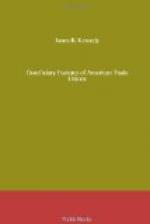The unions that pay a money benefit are the Cigar Makers, the Typographia, the Coal Hoisting Engineers, and the Jewelry Workers.[156] The Cigar Makers’ Union is still the only American trade union of considerable membership which maintains a system of out-of-work benefits under which unemployed members receive a weekly money benefit. On October 11, 1875, the New York branch of the Cigar Makers’ Union formed an out-of-work benefit and became from that time the steady advocate of a national system. As early as 1876 the New York Union proposed a plan to the International Convention, modelled upon the system in operation in the local union, under which a member was entitled to receive aid for a term of three weeks, beginning with the second week of unemployment.[157] This proposal failed of adoption; but the International Convention agreed that sick members should have their cards receipted by the out-of-work seal. Proposals for the establishment of a money out-of-work benefit were made in 1877 and in 1879 at conventions of the Union. Although International President Hurst endorsed the idea in 1876 and recommended that it be placed before the local unions for consideration, the International Convention voted adversely. A substitute, proposed by Mr. Gompers, was adopted in 1879. This provided that every subordinate union should establish a labor bureau for the purpose of securing work for unemployed members.[158] The compromise was by no means satisfactory, and suggestions continued to be made for the establishment of a national out-of-work benefit.[159]
[Footnote 156: The Amalgamated Carpenters, an English union which had in 1902 forty-four branches with 3307 members in the United States, also pay an out-of-work benefit.]
[Footnote 157: Journal, Vol. 1, September, 1876, p. 1.]
[Footnote 158: Cigar Makers’ Journal, Vol. 2, April, 1877, p. 2; Vol. 3, October, 1877, p. 3; Vol. 5, September, 1879, p. 3.]
[Footnote 159: Ibid., Vol. 8, September, 1883, p. 9; Vol. 11, October, 1885, p. 6; Vol. 13, July, 1888, p. 7; Vol. 14, December, 1888, p. 3; Vol. 15, October, 1889, pp. 17-18; Constitution, amended 1889, Art. 8.]
The Cigar Makers’ present national system of out-of-work relief was adopted at the eighteenth session, held in New York City in September, 1889, and became operative in January, 1890. The measure as finally adopted by the International Convention was framed by Mr. Gompers. It provided that the unemployed members should receive three dollars per week and fifty cents for each additional day, that after receiving six weeks’ aid the member should not be entitled to further assistance for seven weeks, and that no member should be granted more than seventy-two dollars during any one year. The original system has remained practically unchanged with the exception that in 1896 the annual allowance per member was reduced.




